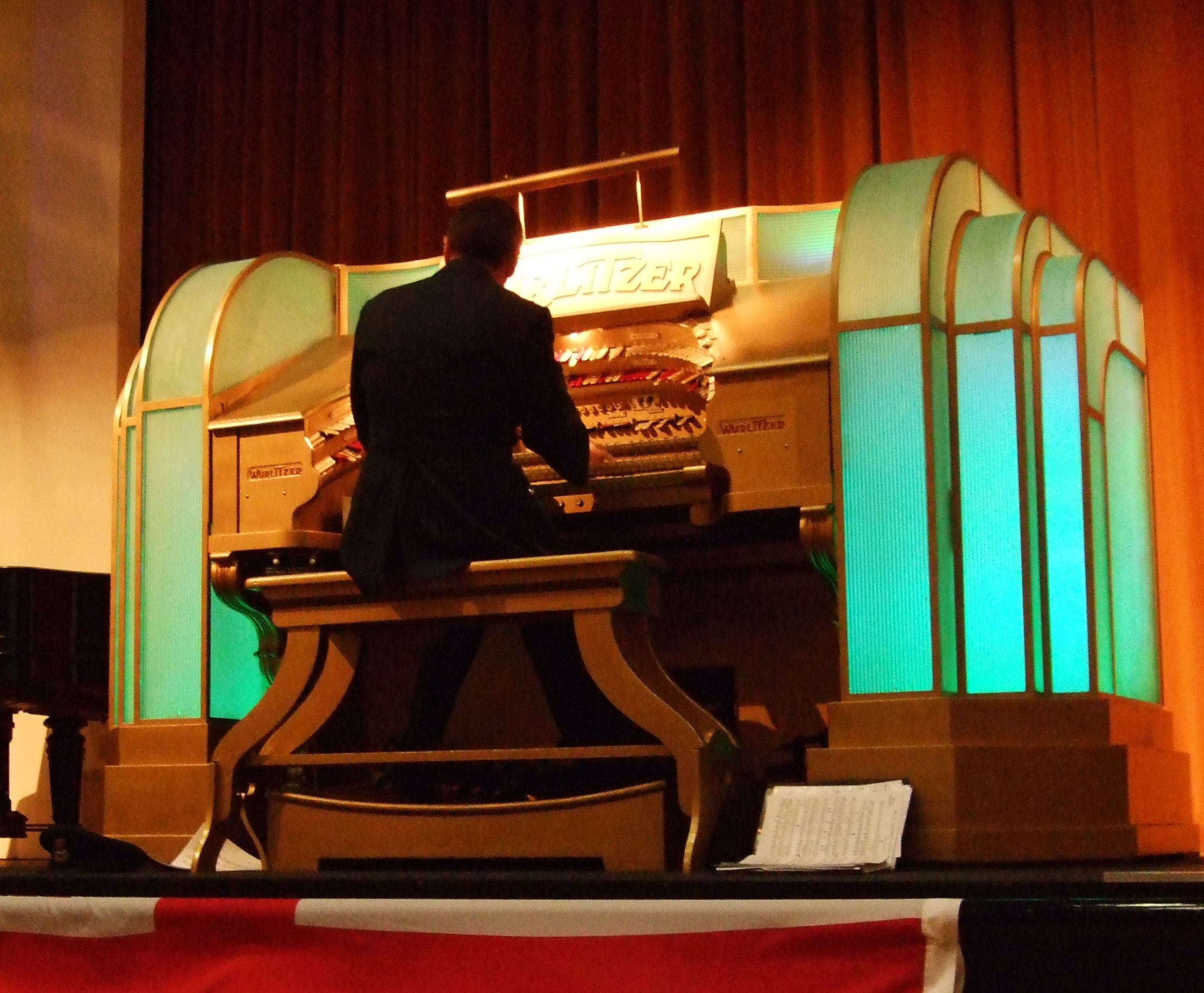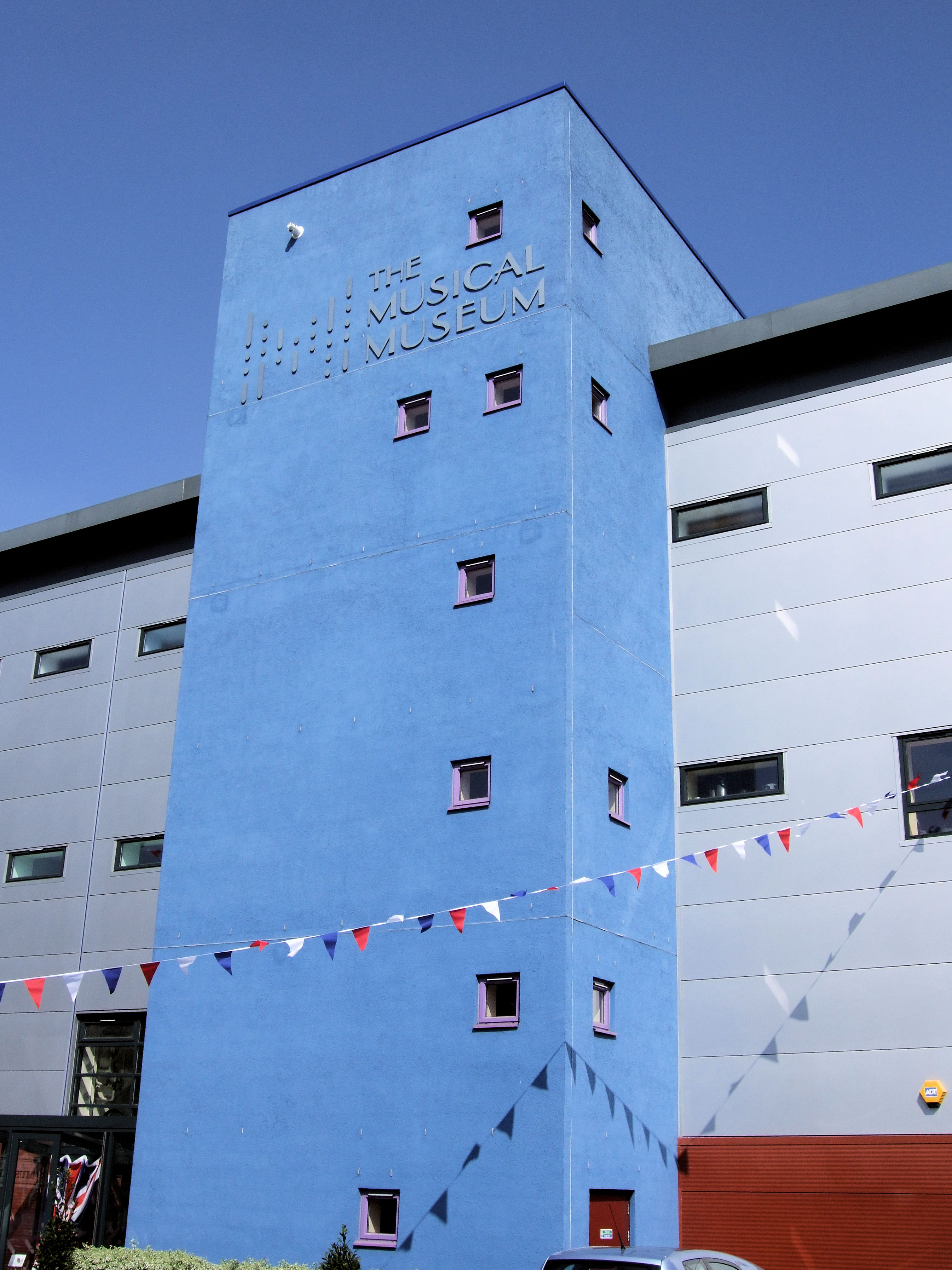|
Wurlitzers In The United Kingdom
A number of Wurlitzer theatre organs were imported and installed in the United Kingdom in the period from 1925 to just before the Second World War (1939–45). The first Wurlitzer theatre organ shipped to the UK was dispatched on 1 December 1924, and shipped in via Southampton Docks. A very small, six-rank instrument, it was installed at the Picture House, Walsall, Staffordshire, where it opened on 26 January 1925. After a period in private ownership in Sedgley, also in Staffordshire, during the mid-1950s, it is now installed and operational in the Congregational Church in Beer, Devon. More details about the Beer Wurlitzer along with photos can be found on the website http://theatreorgans.com/beerwurly/ . The second Wurlitzer theatre organ to be opened in Great Britain was at the Palace Cinema in Tottenham, North London. This instrument was inaugurated on 6 April 1925. Like the Beer Wurlitzer it was a 2-manual, 6-rank instrument. This organ is now located at Rye College in East ... [...More Info...] [...Related Items...] OR: [Wikipedia] [Google] [Baidu] |
Tottenham
Tottenham () is a town in North London, England, within the London Borough of Haringey. It is located in the ceremonial county of Greater London. Tottenham is centred north-northeast of Charing Cross, bordering Edmonton to the north, Walthamstow, across the River Lea, to the east, and Stamford Hill to the south, with Wood Green and Harringay to the west. The area rapidly expanded in the late-19th century, becoming a working-class suburb of London following the advent of the railway and mass development of housing for the lower-middle and working classes. It is the location of Tottenham Hotspur Football Club, founded in 1882. The parish of Tottenham was granted urban district status in 1894 and municipal borough status in 1934. Following the Second World War, the area saw large-scale development of council housing, including tower blocks. Until 1965 Tottenham was in the historic county of Middlesex. In 1965, the borough of Tottenham merged with the municipal boroughs of Ho ... [...More Info...] [...Related Items...] OR: [Wikipedia] [Google] [Baidu] |
Dudley
Dudley is a large market town and administrative centre in the county of West Midlands, England, southeast of Wolverhampton and northwest of Birmingham. Historically an exclave of Worcestershire, the town is the administrative centre of the Metropolitan Borough of Dudley; in 2011 it had a population of 79,379. The Metropolitan Borough, which includes the towns of Stourbridge and Halesowen, had a population of 312,900. In 2014 the borough council named Dudley as the capital of the Black Country. Originally a market town, Dudley was one of the birthplaces of the Industrial Revolution and grew into an industrial centre in the 19th century with its iron, coal, and limestone industries before their decline and the relocation of its commercial centre to the nearby Merry Hill Shopping Centre in the 1980s. Tourist attractions include Dudley Zoo and Castle, the 12th century priory ruins, and the Black Country Living Museum. History Early history Dudley has a history dating back ... [...More Info...] [...Related Items...] OR: [Wikipedia] [Google] [Baidu] |
Tooting
Tooting is a district in South London, forming part of the London Borough of Wandsworth and partly in the London Borough of Merton. It is located south south-west of Charing Cross. History Tooting has been settled since pre- Saxon times. The name is of Anglo-Saxon origin but the meaning is disputed. It could mean ''the people of Tota'', in which context Tota may have been a local Anglo-Saxon chieftain. Alternatively it could be derived from an old meaning of the verb ''to tout'', to look out. There may have been a watchtower here on the road to London and hence ''the people of the look-out post.'' The Romans built a road, which was later named Stane Street by the English, from London (Londinium) to Chichester (Noviomagus Regnorum), and which passed through Tooting. Tooting High Street is built on this road. In Saxon times, Tooting and Streatham (then Toting-cum-Stretham) was given to the Abbey of Chertsey. Later, Suene (Sweyn), believed to be a Viking, may have been g ... [...More Info...] [...Related Items...] OR: [Wikipedia] [Google] [Baidu] |
Mansfield
Mansfield is a market town and the administrative centre of Mansfield District in Nottinghamshire, England. It is the largest town in the wider Mansfield Urban Area (followed by Sutton-in-Ashfield). It gained the Royal Charter of a market town in 1227. The town lies in the Maun Valley, north of Nottingham and near Sutton-in-Ashfield. Most of the 109,000 population live in the town itself (including Mansfield Woodhouse), with Warsop as a secondary centre. Mansfield is the one local authority in Nottinghamshire with a publicly elected mayor. History Roman to Mediaeval Period Settlement dates to the Roman period. Major Hayman Rooke in 1787 discovered a villa between Mansfield Woodhouse and Pleasley; a cache of denarii was found near King's Mill in 1849. Early English royalty stayed there; Mercian Kings used it as a base to hunt in Sherwood Forest. The Royal Manor of Mansfield was held by the King. In 1042 Edward the Confessor possessed a manor in Mansfield. William the Conqu ... [...More Info...] [...Related Items...] OR: [Wikipedia] [Google] [Baidu] |
Tea Dance
__NOTOC__ A tea dance, also called a ''thé dansant'' (French for "dancing tea"), was a dance held in the summer or autumn from 4 to 7 p.m. In the English countryside, a garden party sometimes preceded the dance.''Party-giving on Every Scale'', London, n.d. (1880) "Afternoon Dances". The function grew out of the afternoon tea tradition, and J. Pettigrew traces its origin to the French colonization of Morocco.Pettigrew, J., 2001. "Waltz Around a Tea Table," ''TeaMuse'' nline July 2001. Books on Victorian-era etiquette included detailed instructions for hosting such gatherings, such as ''Party-giving on Every Scale'' (London, n.d. |
Scarborough Fair Collection
The Scarborough Fair Collection is a museum of fairground mechanical organs and showman's engines, located in Scarborough, North Yorkshire, one of the largest collections of its type in Europe. The museum was founded by local Farmer turned entrepreneur and owner of nearby holiday park), Graham Atkinson, who wanted to both indulge his passion for fairgrounds and entertain his holiday park clients. Starting his collection in the late 1980s, the attraction was occasionally open to holiday park residents and enthusiasts until its formal opening in 2008. The collection spans vintage cars, miniature vehicles and model railways, but the three cores to the collection are: *Steam engines: four showman's engines, including ''The Iron Maiden''; a Foden steam wagon; and a Barrows and Co. portable engine *Fairground rides: including an 1893 gallopers ride, a 1928 rare caterpillar ride, 1933 'Noahs Ark', waltzer, cake walk and dodgem cars *Mechanical organs: including the 97-key 'Oktober ... [...More Info...] [...Related Items...] OR: [Wikipedia] [Google] [Baidu] |
Greenford
Greenford () is a suburb in the London Borough of Ealing in west London, England, lying west from Charing Cross. It has a population of 46,787 inhabitants, or 62,126 with the inclusion of Perivale. Greenford is served by Greenford Station (London Underground Central Line and Greenford branch of the Great Western Railway mainline service). South Greenford mainline station (on the A40 Western Avenue, also on the Greenford branch of the GWR) is actually in Perivale. Neither station is in Greenford Town Centre (Greenford Broadway), which instead is served by many local buses. Nearby places include Yeading, Hanwell, Perivale, Southall, Northolt, Ealing, Sudbury and Sudbury Hill. The most prominent landmark in the suburb is Horsenden Hill, above sea level. Greenford covers a large area, including the two miles of Greenford Road, giving it three localities: North Greenford, Greenford Green, and Greenford Broadway – this is also reflected in the names of the electoral wards ... [...More Info...] [...Related Items...] OR: [Wikipedia] [Google] [Baidu] |
Kilburn, London
Kilburn is an area of north west London, England, which spans the boundary of three London Boroughs: London Borough of Camden, Camden to the east, City of Westminster, London Borough of Brent, Brent to the west. There is also an area in the City of Westminster, known as West Kilburn and sometimes treated as a distinct locality. Kilburn High Road railway station lies 3.5 miles (5.6 km) north-west of Charing Cross. Kilburn developed from a linear hamlet that grew up on ancient Watling Street (the modern A5 Road), the hamlet took its name from Kilburn Priory, which was built on the banks of Kilburn Brook. Watling Street forms the contemporary boundary between the boroughs of Brent and Camden. The area has London's highest Irish people, Irish population, as well as a sizable British Afro-Caribbean community, Afro-Caribbean population. The area is identified in the London Plan as one of 35 major centres in Greater London. Geographic and administrative context Kilburn has never ... [...More Info...] [...Related Items...] OR: [Wikipedia] [Google] [Baidu] |
Musical Museum, Brentford
The Musical Museum is a charity, museum and concert venue located in Brentford, London Borough of Hounslow, a few minutes' walk from Kew Bridge railway station. Its stated purpose is to conserve, preserve, and develop nationally important collections related to the history of music reproduction; inform, engage and entertain the public regarding the evolution of music reproduction; and conserve, preserve, promote and present the theatre pipe organ as an instrument with a significant role in the development of light music on radio and in the cinema and as a musical art form. The Musical Museum contains a significant collection of self-playing musical instruments, and one of the world's largest collections of historic musical rolls. The museum houses rare working specimens of player pianos, orchestrions, reed organs, and violin players. The largest exhibits include a fully restored Wurlitzer theatre organ (attached to a roll-playing mechanism and Steinway grand piano) and a 12 ... [...More Info...] [...Related Items...] OR: [Wikipedia] [Google] [Baidu] |
Kingston Upon Thames
Kingston upon Thames (hyphenated until 1965, colloquially known as Kingston) is a town in the Royal Borough of Kingston upon Thames, southwest London, England. It is situated on the River Thames and southwest of Charing Cross. It is notable as the ancient market town in which Saxon kings were crowned and today is the administrative centre of the Royal Borough. Historically in the county of Surrey, the ancient parish of Kingston became absorbed in the Municipal Borough of Kingston-upon-Thames, reformed in 1835. From 1893 to 2021 it was the location of Surrey County Council, extraterritorially in terms of local government administration since 1965, when Kingston became a part of Greater London. Today, most of the town centre is part of the KT1 postcode area, but some areas north of Kingston railway station are within KT2. The United Kingdom Census 2011 recorded the population of the town (comprising the four wards of Canbury, Grove, Norbiton and Tudor) as 43,013, while ... [...More Info...] [...Related Items...] OR: [Wikipedia] [Google] [Baidu] |
Worthing, West Sussex
Worthing () is a seaside town in West Sussex, England, at the foot of the South Downs, west of Brighton, and east of Chichester. With a population of 111,400 and an area of , the borough is the second largest component of the Brighton and Hove built-up area, the 15th most populous urban area in the United Kingdom. Since 2010, northern parts of the borough, including the Worthing Downland Estate, have formed part of the South Downs National Park. In 2019, the Art Deco Worthing Pier was named the best in Britain. Lying within the borough, the Iron Age hill fort of Cissbury Ring is one of Britain's largest. The recorded history of Worthing began with the Domesday Book. It is historically part of Sussex in the rape of Bramber; Goring, which forms part of the rape of Arundel, was incorporated in 1929. Worthing was a small mackerel fishing hamlet for many centuries until, in the late 18th century, it developed into an elegant Georgian seaside resort and attracted the well-kn ... [...More Info...] [...Related Items...] OR: [Wikipedia] [Google] [Baidu] |

.jpg)






